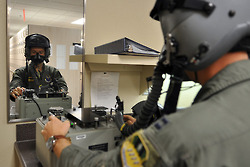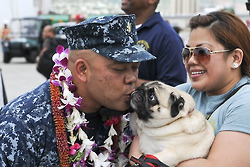
Cmdr. Russell Carr speaking with a staff member. Photo by Bernard S. Little.
By U.S. Navy Cmdr. Russell Carr, Service Chief, Adult Outpatient Behavioral Health Clinic, Walter Reed National Military Medical Center
Just the other day, I found myself thinking about a patient of mine who killed himself.
I had an “anniversary reaction” of sorts. This time of year, the cool weather and sunny, cloudless days, reminded me of him and fall day when he shot himself through the chest. It has been four years since he died, but for a few moments it suddenly felt like that time had disappeared. I was back in the familiar shock and sadness. I remembered the impact his sudden, unexpected suicide had on his unit and the medical staff of our small base. I felt the same loneliness that I felt immediately after his suicide. Just as I did on that day, I wondered again if I could have done anything differently that would have kept him alive.
Memories of sudden loss such as suicide stick with us. Research has shown that we often feel alone and stigmatized when someone close to us commits suicide, whether that person is a relative, friend, or patient. We imagine no one will understand our perspective and might even blame us for the death. Remaining isolated from others due to a sense of guilt or shame leaves us trapped in that time. Time does stand still for us. If we are fortunate enough to find another person with whom we can bear and process such a traumatic experience, then we might be able to move on from it. It is through our connections with others and feeling understood that we can engage with the world again after a devastating loss. We need each other. If we are lucky, we come out of the experience a little wiser and more focused on what is important to us. But we never forget it.
It has taken me some time to come to terms with the suicide of my patient. For me, part of that process has been sharing with others the wisdom I gained from it. Today, I am in a leadership role in our Psychiatry Department at Walter Reed National Military Medical Center, in Bethesda, Md. This affords me the opportunity to help staff and others prevent suicides and to process the experience when they do occur. I teach psychiatry residents about the impact that a suicide can have on them as a provider and as a person. I also teach them the importance of recognizing when a patient seems to have lost hope and, as my patient put it in his suicide note, “can no longer see the light at the end of the tunnel.” My effort to teach and support other mental health providers is my memorial to my patient. It is what I now do in his memory. (more…)









Recent Comments